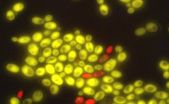(Press-News.org) A new University of Colorado Boulder framework used to screen hundreds of organic chemical compounds used in hydraulic fracturing, or fracking, shows that 15 may be of concern as groundwater contaminants based on their toxicity, mobility, persistence and frequency of use.
Using a fast groundwater transport scenario, the team predicted that 41 of the 659 organic compounds screened would have 10 percent or more of their initial concentrations remaining at a transport distance of roughly 300 feet. That is the average state "setback" distance in the United States between a fracking well and a drinking water well, said CU-Boulder Professor Joseph Ryan, the principal investigator on the study.
In the fracking process, a mixture of water, sand and various chemicals is pumped into wells at high pressure to create fissures in subterranean shale layers to release natural gas and oil. Oil and gas companies use a wide variety of chemicals to increase viscosity, inhibit equipment corrosion and reduce friction, among other things.
The 659 compounds screened by the CU-Boulder team were gleaned in large part from the nationwide FracFocus Chemical Disclosure Registry used by many states in which companies disclose chemical information about most of the ingredients used in the fracking process at individual wells. The CU-Boulder team obtained data from more than 50,000 wells in Colorado, North Dakota, Pennsylvania and Texas since 2011, said Ryan, a faculty member in the Department of Civil, Environmental and Architectural Engineering.
"We wanted to evaluate which compounds we should be paying attention to based not just on toxicity but also on the extent a particular compound travels from one place to another through groundwater," said Ryan. "We found 41 compounds that were considered mobile and persistent, and a handful of those we would not want in our drinking water."
Corresponding study author Jessica Rogers, a CU-Boulder doctoral student in civil, environmental and architectural engineering, said the remaining 26 compounds predicted to be mobile and persistent were very rare and were identified in fewer than 50 of the 50,000 FracFocus reports analyzed for the CU-Boulder study.
Ryan said the new study may reduce the alarm associated with statements that imply that hundreds of chemical compounds used in hydraulic fracturing fluid are at risk of contaminating groundwater. "But it also demonstrates a subset of these compounds could result in potentially hazardous exposures following spills or well failures."
A paper on the subject was published online in Environmental Science & Technology Letters published by the American Chemical Society. Co-authors included CU-Boulder researcher Troy Burke and Cal Poly Pomona Associate Professor Stephen Osborn. The work was funded by the National Science Foundation and a U.S. Environmental Protection Agency STAR fellowship to Rogers, first author on the paper.
"There were two main objectives with this project," said Rogers. "The first was to develop a screening process that could be used by researchers or others to prioritize organic fracking compounds based on how mobile and persistent they are in groundwater. The second was to use the framework to perform an initial screening based on currently available knowledge on the compounds identified in fracturing fluid by FracFocus."
The screening process included using known degradation rates of particular organic compounds horizontally transported from a point of release, like a failed well casing, to a drinking water well, said Ryan. The researchers took into consideration the chemical structure and stability of each organic compound and its behavior in water. They also used a wastewater treatment process simulator called BIOWIN 4 to help estimate the biodegradation of the organic compounds over time.
Of the 15 compounds that were found to be of concern as groundwater contaminants in the CU-Boulder assessment, only two of those - naphthalene and 2-butyoxyethanol - were identified on more than 20 percent of the 50,000 FracFocus reports. Only four of the compounds were identified on more than 5 percent of the reports.
The two transport scenarios considered were a highly porous aquifer with relatively fast groundwater velocity and a less porous aquifer with slower velocity. Compounds were evaluated for potential toxicity using the National Primary Drinking Water Regulations and Health Assessment Information, said Ryan.
"Just because a compound has been put into the ground doesn't mean it is going to migrate to a place where humans will be exposed to it," said Ryan. "On the other hand, problems with particular compounds in groundwater could take a decade or so to even show up. We don't know enough about some of these processes right now."
One persistent complaint by environmental groups is that information posted by the FracFocus registry has only been on a well-by-well basis and only in a PDF format, making it extremely difficult to assemble large and meaningful data sets, said Ryan.
"We found out that pulling out data we needed, like how frequently a particular compound was used in hydraulic fracturing in wells across the country, was not so easy to do," Ryan said. "But to evaluate mobility and persistence, we used existing tools so that others follow the same approach for looking at other organic compounds of interest."
The next stage of the CU-Boulder research effort could involve looking at chemical products produced by the breakdown of fracking fluids or considering the return of known fracking compounds to the surface, said Rogers. "Currently we don't have enough information on these processes to account for them consistently in our screening framework, but the science is rapidly evolving."
INFORMATION:
Ryan is the principal investigator on a $12 million grant from NSF made to a CU-Boulder-led team in 2012 to explore ways to maximize the benefit of natural gas development while minimizing the negative impacts in ecosystems and communities.
Contact:
Joseph Ryan, 303-492-0772
joseph.ryan@colorado.edu
Jim Scott, CU-Boulder media relations, 303-492-3114
jim.scott@colorado.edu
Researchers at University of California, San Diego School of Medicine have discovered a cell signaling pathway that appears to exert some control over initiation and progression of colorectal cancer, the third leading cause of cancer-related death in the United States. A key protein in the pathway also appears to be predictive of cancer survival rates.
The study is reported in the June 30 issue of eLife.
The protein, known as Dishevelled-associating protein with a high frequency of leucine residues or Daple, is produced by nearly all healthy cells in the body and is ...
Brigham and Women's Hospital finds that developing and implementing an interdisciplinary care improvement initiative improves outcomes.
Approximately 20 percent of all patients admitted to a hospital have a mental health condition, either as a primary or a secondary diagnosis, and a recent report by the Institute of Medicine warned that there is a critical shortage of health care professionals who are equipped to provide mental health and geriatric care to these patients in the hospital setting. Often, these patients experience delirium, alcohol withdrawal and suicide ...
The universe can be a very sticky place, but just how sticky is a matter of debate.
That is because for decades cosmologists have had trouble reconciling the classic notion of viscosity based on the laws of thermodynamics with Einstein's general theory of relativity. However, a team from Vanderbilt University has come up with a fundamentally new mathematical formulation of the problem that appears to bridge this long-standing gap.
The new math has some significant implications for the ultimate fate of the universe. It tends to favor one of the more radical scenarios ...
MAYWOOD, IL - In recent years, there has been widespread media coverage of studies purporting to show that radiation from X-rays, CT scans and other medical imaging causes cancer.
But such studies have serious flaws, including their reliance on an unproven statistical model, according to a recent article in the journal Technology in Cancer Research & Treatment. Corresponding author is Loyola University Medical Center radiation oncologist James Welsh, MS, MD.
"Although radiation is known to cause cancer at high doses and high-dose rates, no data have ever unequivocally ...
Poor sleep is associated with negative mood in women with bipolar disorder, according to researchers at Penn State College of Medicine and University of Michigan Medical School.
Bipolar disorder is a brain disorder that causes unusual shifts in mood, energy, activity levels and the ability to carry out day-to-day tasks. The condition is marked by extreme mood episodes characterized as manic (highs) depressive (lows) or mixed.
Sleep problems are common in people with bipolar disorder, and poor sleep quality and bipolar disorder appear to exacerbate each other. Previous ...
Carnegie Mellon University chemists have developed two novel methods to characterize 3-dimensional macroporous hydrogels -- materials that hold great promise for developing "smart" responsive materials that can be used for catalysts, chemical detectors, tissue engineering scaffolds and absorbents for carbon capture.
Researchers working in the lab of Carnegie Mellon Professor Krzysztof Matyjaszewski published their results in the May issue of Advanced Science, with the article featured on the journal's back cover. Their findings are the latest in Matyjaszewski lab's long ...
Bisexual males and females report poorer health than gays, lesbians and heterosexuals, according to a new study from sociologists at Rice University.
"A New Piece of the Puzzle: Sexual Orientation, Gender and Physical Health Status" will appear in an upcoming edition of Demography. The study examined the self-rated health of 10,128 sexual minorities (gay, lesbian and bisexual adults) and 405,145 heterosexual adults to see how it differed across sexual orientation.
"According to the Institute of Medicine, existing health research on the sexual minority population is ...
For centuries, humans have been playing with yeast. But these simple fungal cells usually do their jobs -- making bread rise or converting sugar into alcohol -- without having to communicate or work together.
Now, a team of University of Washington researchers has engineered yeast cells (Saccharomyces cerevisiae) that can "talk" to one another, using a versatile plant hormone called auxin.
In a paper published June 23 in the American Chemical Society's journal ACS Synthetic Biology, the researchers describe a novel cell-to-cell communication system that enables one ...
People on a vegetarian diet, and especially those following a vegan one that includes no animal products, see better results than dieters on other weight-reducing plans. In fact, they can lose around two kilograms more on the short term, says Ru-Yi Huang of E-Da Hospital in Taiwan after reviewing the results of twelve diet trials. The findings¹ appear in the Journal of General Internal Medicine², published by Springer.
Huang's review includes twelve randomized controlled trials, involving 1,151 dieters who followed a specific eating regime for between nine ...
German researchers found osteopathic manipulative therapy (OMTh) decreased postpartum low back pain by over 70 percent in women who had given birth at least three months before beginning treatment, according to a new study published in July issue of the Journal of the American Osteopathic Association.
The eight week study, devised as a pragmatic randomized controlled trial, surveyed 80 women experiencing low back pain three to 15 months postpartum. Women in the study group received four OMTh treatments at two week intervals. Participants in the control group did not ...

